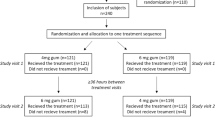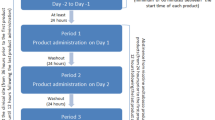Abstract
In a randomized smoking cessation study 211, 203 and 82 persons were supported with nicotine, silver acetate and ordinary chewing gum, respectively. After 26 weeks there was no overall difference in number of abstainers between treatments. Participants were divided into subsets with low and high weighted packyears consumption (WPY) which modifies tobacco consumption by nicotine content. Abstainer rates in the total population controlled for treatment decreased with increasing WPY (P<0.005). In participants with low WPY abstainer rate was higher in the silver acetate group compared to the nicotine (P<0.0005) and ordinary (P<0.05) chewing gum groups. Nicotine chewing gum was more effective than silver acetate (P<0.05) and ordinary (P<0.05) chewing gum in smokers with high WPY. Ratings on some inconveniences experienced during earlier attempts to quit smoking influenced the ability to break the habit but had no influence on chewing gum effects. This study indicated that through consideration of smoking history it should be possible to individualize pharmacological support to smokers wanting to quit, with silver acetate chewing gum most effective for smokers with a low WPY and nicotine chewing gum most effective for smokers with a high WPY.
Similar content being viewed by others
References
BMDP Statistical Software (1985) University of California Press, Los Angeles
Cherry N, Kirnan K. Personality scores and smoking behaviour. A longitudinal study. Br J Soc Med 1976; 30:123–131
Cummings KM, Giovino G, Jaen CR, Emrich LJ (1985) Reports of smoking withdrawal symptoms over a 21 day period of abstinence. Addict Behav 10:373–381
Cummings KM, Jaen CR, Giovino G (1985) Circumstances surrounding relapse in a grup of recent ex-smokers. Prevent Med 14:373–381
Fagerstrom KO (1982) A Comparison of psychological and pharmacological treatment in smoking cessation. J Behav Med 5:343–351
Fagerstrom KO (1984) Effects of nicotine chewing gum and follow-up appointments in physician-based smoking cessation. Prevent Med 13:517–527
Fee WM, Steward MJ (1982) A controlled trial of nicotine chewing gum in a smoking withdrawal clinic. Practitioner 226:148–151
Fielding JE (1985) Smoking: health effects and control. N Engl J Med 313:491–498
Friedman LM, Furberg CD, DeMets DL (1982) Fundamentals of clinical trials. John Wright PSG, Bristol, pp 69–87
Hall SM, Tunstall CD, Ginsberg D, Benowitz NL, Jones RT (1987) Nicotine gum and behaverioural treatment: a placebocontrolled trial. J Consutt Clin Psychol 55:603–605
Hjalmerson AIM (1984) Effect of nicotine chewing gum in smoking cessation. JAMA 252:2835–2838
Hughes JR, Krahn D (1985) Blindness and the validity of the double-blind procedure. J Clin Psychopharm 5:138–140
Jarvis ME, Russell MAH, Salooje Y (1980) Expired air carbon monoxid: a simple breath test of tobacco smoke intake. Br Med J 281:484–485
Jarvis MJ, Raw M, Russel MAH, Feyerabend C (1982) Randomized controlled trial of nicotine chewing gum. Br Med J 285:537–540
Jensen EJ, Schmidt E, Pedersen B, Dahl R (1991) Effect of nicotine, silver acetate and nicotine chewing gum in combination with group councelling on smoking cessation. Thorax (in press)
Malcolm R (1986) Silver acetate gum as a smoking deterrent. Chest 89:107–111
Murray E, Schneider NG (1984) Degree of addiction and effectiveness of nicotine gum therapy for smoking. Am J Psycho 141:790–791
Raw M, Jarvis MJ, Feyerabend C, Russell MAH (1980) Comparison of nicotine chewing gum and psychological treatment for dependent smokers. Br Med J 281:481–482
Schmidt F (1977) Raucherentwöhnung durch Anti-Raucher Kaugummi Dragees im Doppelblindversuch. Munch Med Wschr 119:1343–1344
Schneider NG, Jarvik ME, Forsythe AB, Read LL, Elliot ML, Schweiger A (1983) Nicotine gum in smoking cessation: a placebo-controlled, double-blind trial. Addict Behav 8:253–261
Tonnesen P, Fryd V, Hansen M, Helsted J, Gunnersen AB, For chammer H, Stockner M (1988) Effect of nicotine gum in combination with group counselling on the cessation of smoking. N Engl J Med 318:15–18
West DV, Graham S, Swanson M, Wilkinson G (1977) Five year follow up of a smoking withdrawal clinic. Am J Public Health 30:123–131
Author information
Authors and Affiliations
Rights and permissions
About this article
Cite this article
Jensen, E.J., Schmidt, E., Pedersen, B. et al. Effect on smoking cessation of silver acetate, nicotine and ordinary chewing gum. Psychopharmacology 104, 470–474 (1991). https://doi.org/10.1007/BF02245651
Received:
Revised:
Issue Date:
DOI: https://doi.org/10.1007/BF02245651




